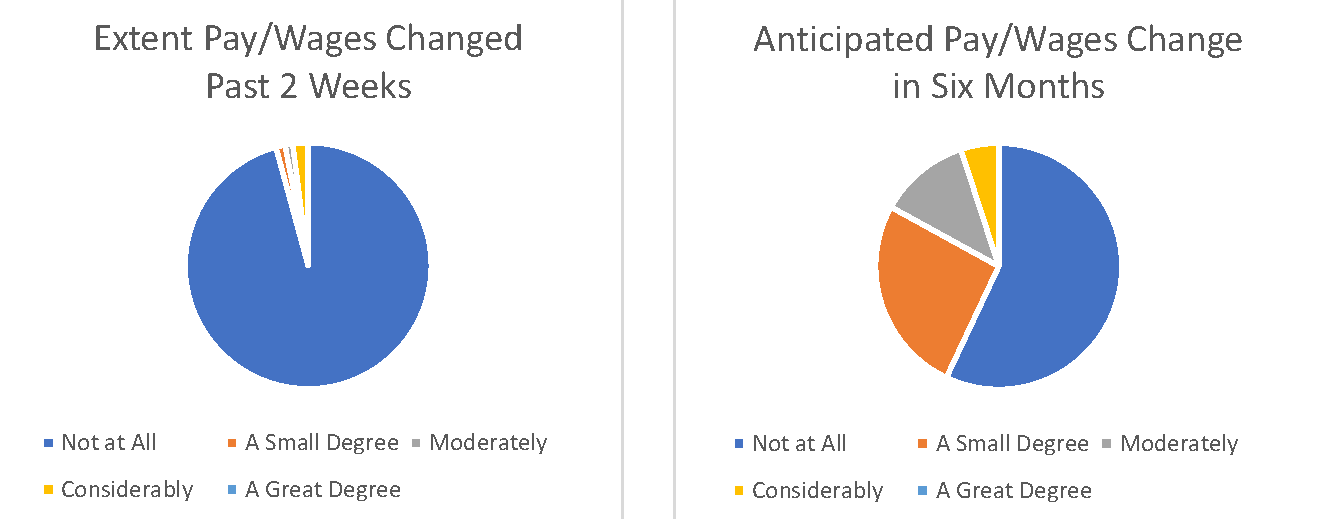Newly Remote Employees During the COVID-19 Pandemic: A Snapshot of Their Perceptions, Feelings and Concerns
We recently initiated a research project to gather information from newly remote employees to assess their current life circumstances; their perceptions, feelings and behaviors; their top concerns, as well as positive aspects of their life currently.
Study Participants
Eighty-five newly remote employees responded to an invitation to fill out an online questionnaire about working remotely (88% Female, 12% Male). The questionnaires were completed within two business days (ending March 30, 2020), just after “Stay In Place” orders had been put in place for several states, and just prior to the Federal CARE Act being passed by the Senate.
Interestingly, 41% of the respondents had been working remotely only one week when they completed the questionnaire; 53% had been working remotely just two weeks; and six percent had been working remotely three weeks.
< 24 4%
25 – 39 years old 33%
40 – 54 years old 47%
55 – 70 17%
Twenty-six percent live in urban settings, 55% live in suburban areas, while 19% were from rural areas.
Themes Discovered
Financial. Although the majority of the respondents reported that their pay / wages had not changed in the past two weeks, many of them anticipate a change in their finances in the next six months. Further, over half of the respondents (51%) experienced moderate to high levels of anxiety over their future financial status.
Distractions from Working Remotely. In exploring the level and types of distractions the new remote employees were experiencing, the following were discovered.
- Of the 35 respondents who reported having children living in the home, most (58%) indicated that their children did not significantly impact their ability to work efficiently.
- The lack of opportunity to interact with team members was a moderate distractor to getting work accomplished (50% indicating a moderate, considerable or great level of distraction).
- Being emotionally spent / mentally overloaded was the greatest distraction identified (56% reported a great, considerable, or moderate amount).
Anxiety
Overall, the group reports moderate amounts of anxiety (Moderately, 34%; Quite a bit, 28%; Extremely, 5%). However, their anxiety was primarily focused upon the impact of the pandemic on others (both globally and loved ones) verses themselves. Here are the percentages of respondents who reported a considerable or great degree of anxiety over the following:
Impact of Coronavirus on World at Large 55%
The Overall Economy 42%
Health of a Family Member 35%
Ability to Buy What is Needed 23%
Personal Future Financial Status 19%
Personal Health 14%
Positive Responses to Life Challenges
A number of positive responses were reported by the respondents, including:
- Being Thankful. The highest positive characteristic was thankfulness, by 97% of the employees (Extremely, 35%; Quite a bit, 35%; Moderate, 27%).
- Happy. Eighty-five percent (85%) of respondents report being extremely (2%), quite a bit (30%) or moderately (53%) happy. Especially given their level of anxiety, it is encouraging to know that people are still in good spirits.
- Determination. This group largely (81%) indicates they are responding to difficult circumstances with determination, which is good news for employers (Extremely, 11%; Quite a bit, 34%; Moderate, 36%).
- Hopeless (not feeling). These employees (97%) report not feeling hopeless (Not at all, 70%; A little, 27%).
- Productive. Again, good news. 83% feel at least moderately productive (Extremely, 6%; Quite a Bit, 36%; Moderately, 41%).
- Lonely (not feeling). We anticipate loneliness to increase, but right now the level is quite low (Not at all, 22%; A little, 54%).
Self-care
A number of self-care behaviors were investigated (regular exercise, adequate sleep, eating healthily, taking breaks, binge watching the news). Most behaviors (self-reported) were in the moderate range (40% – 60%). Most notable was that a large percentage (60%) reported binge watching the news, either “everyday” or “often”.
Personalized Responses
At the end of the questionnaire, three open-ended questions were asked to allow individuals to more fully describe their responses.
1. What is the single greatest concern you have been facing in your life this week?
- 42% Health Concerns (Family & Self). “Keeping my parents safe / healthy”, “The health and well-being of my family”, “Not getting sick”
- 27% Work-Life Balance & Family Relationships. “Balancing working from home with family needs”, “Concern for my mother in a retirement home”, “Balancing work with a 1st grader at home”
2. What was the biggest challenge you had to manage in your life this week?
- 52% Work-Related Challenges. “Keeping focused on work”, “Working by phone vs. physically meeting clients”, “Technology needs for my team”
- 28% Dealing with family issues. “Being patient with my mother who is temporarily living with me”, “Trying to support my daughter’s online schooling while working”, “Challenges managing my two teenagers who want to get together with friends”
3. What positive experiences did you have this week as a result of working at home?
- 50% Time with Family “Taking walks with my family” “Being able to eat lunch with my wife” “Being home with my baby”
- 48% More Time (Less Commuting “No commuting means more time!” “More time for sleep and self-care”
Summary
Rather than draw general conclusions at this point, we would rather let the findings speak for themselves, with two exceptions. We were impressed with: 1) the generally positive tone of responses from the participants and 2) the clear theme of newly remote employees enjoying more personal time (especially with family members) due to less time commuting.
In interpreting this data, it is important to remember that: a) this is an “one point in time” snapshot; b) the respondents were all currently employed remotely (vs. unemployed or furloughed); and c) we will be obtaining a more complete picture from our current four-week study, where we are following 50 employees who are working from home.
It is interesting to note how different these results are from other recent surveys of adults in general in the U.S., many of whom are unemployed or furloughed. This provides an important reminder to organizational leaders and managers not to infer the results from the national studies of the general population which may not accurately reflect your employees.
*****
Training Mag – New WFH Employees – Private use
 This article was co-written with Dr. Natalie Hamrick.
This article was co-written with Dr. Natalie Hamrick.
Natalie Hamrick, Ph.D., is a Research Psychologist with expertise in stress, coping and health. She is the author of Cope by Faith: Partnering With God to Get Through and Triumph From the Cancer Experience and serves as a Project Specialist at Appreciation at Work.
Tags: COVID-19, remote, Remote employees, WFH, Work From Home, Working from homeCategories Gratitude, Perseverance, Remote Employees, Stress management, Virtual teams, Work



3 Comments
Anxiously awaiting the results of your 4 week study. It is now 10 weeks for me working from home
Sorry for the delay. The full article is to be published next week in Training magazine. However, Google for Dr Paul White + Psychology Today + remote employees and you’ll find an interview that discusses some of the findings. Once the link is posted for the full article we’ll mention it in the newsletter.
Sorry for the delay. The full article is to be published next week in Training magazine. However, Google for Dr Paul White + Psychology Today + remote employees and you’ll find an interview that discusses some of the findings. Once the link is posted for the full article we’ll mention it in the newsletter.